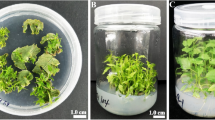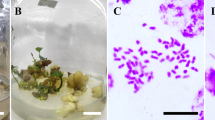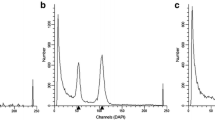Abstract
As a model plant, poplar 84 K (Populus alba × P. glandulosa) plays a key role in fundamental research in forest molecular biology. Poplar 84 K is a suitable plant for in vitro polyploidy induction and to study the consequent trait variation among perennial trees. In this study, the results indicated that the concentration of NAA (naphthaleneacetic acid) and BA (benzyladenine) has substantial effects on the differentiation rate of adventitious shoots, and media consisting of 0.5 mg L−1 BA and 0.05 mg L−1 NAA yielded the greatest number of shoots per explant. A total of 98 tetraploids were successfully obtained by colchicine treatment on diploid leaves in vitro. The rate of tetraploids was substantially affected by pre-culture duration, colchicine concentration and exposure duration. The highest tetraploid induction efficiency was 37.03%, which was achieved by treating leaves with 50 mg L−1 colchicine for 3 days after 4 days of pre-culture. With increasing ploidy, obvious morphological differences were discovered between tetraploids and diploids. Compared with the diploids, the tetraploids had larger and thicker leaves, larger but sparser stomata, fewer and shorter roots, and larger protoplasts. These tetraploids serve to enrich the polyploid germplasm resources of Populus. Moreover, our study lays an important groundwork for polyploid gene function and is important for exploring trait variation among Populus trees with different ploidy levels.
Key message
In vitro induction of tetraploid by colchicine treatment and differences in morphological features between tetraploid and diploid plants.







Similar content being viewed by others
Abbreviations
- MS:
-
Murashige and Skoog (1962)
- BA:
-
Benzyladenine
- NAA:
-
1-Naphthaleneacetic acid
- IBA:
-
Indole butyric acid
- DAPI:
-
4,6-Diamidino-2-phenylindole
- MOPS:
-
4-Morpholinepropane sulfonate
- CPW:
-
Cell protoplast washing medium
- MES:
-
4-Morpholine ethane sulfonic acid
- BS:
-
Bovine serum albumin
- LSD:
-
Least significant difference
- SE:
-
Standard error
- SEM:
-
Scanning electron microscopy
References
Allario T, Brumos J, Colmenero-flores JM, Tadeo F, Froelicher Y, Talon M, Navarro L, Ollitrault P, Morillon R (2011) Large changes in anatomy and physiology between diploid Rangpur lime (Citrus limonia) and its autotetraploid are not associated with large changes in leaf gene expression. J Exp Bot 62(8):2507–2519. https://doi.org/10.1093/jxb/erq467
Allum JF, Bringloe DH, Roberts AV (2007) Chromosome doubling in a Rosa rugosa Thunb. hybrid by exposure of in vitro nodes to oryzalin: the effects of node length, oryzalin concentration and exposure time. Plant Cell Rep 26(11):1977–1984. https://doi.org/10.1007/s00299-007-0411-y
Ascough GD, Van SJ, Erwin JE (2008) Effectiveness of cholchicine and oryazlin at inducing polyploidy in Watsonia lepida N.E. Brown. Hortscience Horts 43(7):2248–2251. https://doi.org/10.21273/HORTSCI.43.7.2248
Blakeslee AF, Avery AG (1937) Methods of inducing doubling of chromosomes in plants by treatment with colchicine. J Hered 28:393–411. https://doi.org/10.1093/oxfordjournals.jhered.a104294
Cai X, Kang XY (2011) In vitro tetraploid induction from leaf explants of Populus pseudo-simonii Kitag. Plant Cell Rep 30:1771–1778. https://doi.org/10.1007/s00299-011-1085-z
Campos JMS, Davide LC, Salgado CC, Santos FC, Costa PN, Silva PS, Alves CCS, Viccini LF, Pereira AV (2009) In vitro induction of hexaploid plants from triploid hybrids of Pennisetum purpureum and Pennisetum glaucum. Plant Breed 128:101–104. https://doi.org/10.1111/j.1439-0523.2008.01546.x
Casimiro I, Beeckman T, Graham N, Bhalerao R, Zhang HM, Casero P, Sandberg G, Bennett MJ (2003) Dissecting Arabidopsis lateral root development. Trends Plant Sci 8(4):165–171. https://doi.org/10.1016/S1360-1385(03)00051-7
Cohen H, Fait A, Tel-Zur N (2013) Morphological, cytological and metabolic conseque- nces of autopolyploidization in Hylocereus (Cactaceae) species. BMC Plant Biol 13:173. https://doi.org/10.1186/1471-2229-13-173
Comai L (2005) The advantages and disadvantages of being polyploid. Nat Rev Gen 6:836–846. https://doi.org/10.1038/nrg1711
Cui YH, Hou L, Li X, Huang FY, Pang XM, Li YY (2017) In vitro induction of tetraploid Ziziphus jujuba Mill. var. spinosa plants from leaf explants. Plant Cell Tiss Organ Cult 131:175–182. https://doi.org/10.1007/s11240-017-1274-8
Dermen H (1940) Colchicine polyploidy and technique. Bot Rev 6:599–635. https://doi.org/10.1007/BF02919557
Dermen H, Henry FB (1944) A general cytohistological study of colchicine polyploidy in Cranberry. Am J Bot 31:451–463
Dhooghe E, Laere KV, Eeckhaut T, Leus L, Huylenbroeck JV (2010) Mitotic chromosome doubling of plant tissues in vitro. Plant Cell Tiss Organ Cult 104(3):359–373. https://doi.org/10.1007/s11240-010-9786-5
Doležel J, Binarová P, Lucretti S (1989) Analysis of nuclear DNA content in plant cells by flow cytometry. Biol Plant 31:113–120. https://doi.org/10.1007/BF02907241
Einspahr DW (1984) Production and utilization of triploid hybrid aspen. Iowa State J Res 58:401–409
Ewald D, Ulrich K, Naujoks G, Schrӧder MB (2009) Induction of tetraploid poplar and black locust plants using colchicine: chloroplast number as an early marker for selecting polyploids in vitro. Plant Cell Tiss Organ Cult 99(3):353–357. https://doi.org/10.1007/s11240-009-9601-31
Galbraith DW, Harkins KR, Maddox JM, Ayres NM, Sharma DP, Firoozabady E (1983) Rapid flow cytometric analysis of the cell cycle in intact plant tissues. Science 220(4601):1049–1051. https://doi.org/10.1126/science.220.4601.1049
Gu XF, Yang AF, Meng H, Zhang JR (2005) In vitro induction of tetraploid plants from diploid Zizyphus jujuba Mill. Cv. Zhanhua. Plant Cell Rep 24(11):671–676. https://doi.org/10.1007/s00299-005-0017-1
Guo LQ, Zhang JG, Liu XX, Rao GD (2019) Polyploidy-related differential gene expression between diploid and synthesized allotriploid and allotetraploid hybrids of Populus. Mol Breed 39:69. https://doi.org/10.1007/s11032-019-0975-6
Huang Z (2015) Studies on suspension cell line establishment and protoplast culture of populous spp. (Section Tacamahaca). Dissertation, Beijing Forestry University
Johnsson H (1945) The triploid progeny of the cross diploid 9 tetraploid Populus tremula. Hereditas 31:411–440. https://doi.org/10.1111/j.1601-5223.1945.tb02761.x
Kang XY (2020) Research progress and prospect of triploid breeding of forest trees. Sci Sin Vitae 50:136–143 (in Chinese with English abstract)
Lavenus J, Goh T, Roberts I, Guyomarc’h S, Lucas M, De Smet I, Fukaki H, Beeckman T, Bennett M, Laplaze L (2013) Lateral root development in Arabidopsis: fifty shades of auxin. Trends Plant Sci 18(8):450–458. https://doi.org/10.1016/j.tplants.2013.04.006
Liao T, Cheng SP, Zhu XH, Min Y, Kang XY (2016) Effects of triploid status on growth, photosynthesis, and leaf area in Populus. Trees-Struct Funct 30(4):1137–1147. https://doi.org/10.1007/s00468-016-1352-2
Liu WT, Zheng YF, Song SY, Huo BB, Li DL, Wang J (2018) In vitro induction of allohexaploid and resulting phenotypic variation in Populus. Plant Cell Tiss Organ Cult 134:183–192. https://doi.org/10.1007/s11240-018-1411-z
Lu M, Zhang PD, Kang XY (2013) Induction of 2n female gametes in Populus adenopoda Maxim by high temperature exposure during female gametophyte development. Breed Sci 63(1):96–103. https://doi.org/10.1270/jsbbs.63.96
Mattila RE (1961) On the production of the tetraploid hybrid aspen by colchicine treatment. Hereditas 47(3–4):631–640. https://doi.org/10.1111/j.1601-5223.1961tb01792.x
Mergen F, Lester DT (1971) Colchicine induced polyploidy in Abies. For Sci 7:314–319
Morejohn LC, Bureau TE, Molè-Bajer J, Bajer AS, Fosket DE (1987) Oryzalin, a dinitroaniline herbicide, binds to plant tubulin and inhibits microtubule polymerization in vitro. Planta 172:252–264. https://doi.org/10.2307/23379101
Mu HZ, Liu ZJ, Lin L, Li HY, Jiang J, Liu GF (2012) Transcriptomic analysis of phenotypic changes in birch (Betula platyphylla) autotetraploids. Int J Mol Sci 13(10):13012–13029. https://doi.org/10.3390/ijms131013012
Murashige T, Skoog F (1962) A revised medium for rapid growth and bio assays with tabacco tissue cultures. Physiol Plant 15:473–497. https://doi.org/10.1111/j.1399-3054.1962.tb08052.x
Nibau C, Gibbs DJ, Coates JC (2008) Branching out in new directions: the control of root architecture by lateral root formation. New Phytol 179(3):595–614. https://doi.org/10.1111/j.1469-8137.2008.02472.x
Nilanthi D, Chen XL, Zhao FC, Yang YS, Wu H (2009) Induction of tetraploids from petiole explants through colchicine treatments in Echinacea purpurea L. J Biomed Biotechnol. https://doi.org/10.1155/2009/343485
Nilsson-Ehle H (1936) Note regarding the gigas from of Populus tremula found in nature. Hereditas 21:372–382
Parsons JL, Martin SL, James T, Golenia G, Boudko EA, Hepworth SR (2019) Polyploidization for the Genetic Improvement of Cannabis sativa. Front Plant Sci 10:476. https://doi.org/10.3389/fpls.2019.00476
Petersen KK, Hagberg P, Kristiansen K (2003) Colchicine and oryzalin mediated chro- mosome doubling in different genotypes of Miscanthus sinensis. Plant Cell Tiss Organ Cult 73:137–146. https://doi.org/10.1023/A:1022854303371
Petricka JJ, Winter CM, Benfey PN (2012) Control of Arabidopsis root development. Annu Rev Plant Biol 63:563–590
Planchais S, Glab N, Inzé D, Bergonioux C (2000) Chemical inhibitors: a tool for plant cell cycle studies. FEBS Lett 476(1–2):78–83. https://doi.org/10.1016/s0014-5793(00)01675-6
Qiu DY, Bai SL, Ma JC, Zhang LS, Shao FJ, Zhang KK, Yang YF, Sun T, Huang JL, Zhou Y, Galbraith DW, Wang ZS, Sun GL (2019) The genome of Populus alba x Populus tremula var glandulosa clone 84K. DNA Res 26(5):423–431. https://doi.org/10.1093/dnares/dsz020
Rêgo MD, Rêgo ER, Bruckner CH, Finger FL, Otoni WC (2011) In vitro induction of autotetraploids from diploid yellow passion fruit mediated by colchicine and oryzalin. Plant Cell Tiss Organ Cult 107:451–459. https://doi.org/10.1007/S11240-011-9995-6
Roy AT, Leggett G, Koutoulis A (2001) In vitro tetraploid induction and generation of tetraploids from mixoploids in hop (Humulus lupulus L.). Plant Cell Rep 20:489–495. https://doi.org/10.1007/s002990100364
Sakhanokho HF, Rajasekaran K, Kelley RY, Islam-Faridi N (2009) Induced polyploidy in diploid ornamental ginger (Hedychium muluense R.M. Smith) using colchicine and oryzalin. HortScience horts 44(7):1809–1814. https://doi.org/10.21273/HO-RTSCI.44.7.1809
Sari N, Abak K, Pitrat M (1999) Comparison of ploidy level screening methods in watermelon: Citrullus lanatus (Thunb.) Matsum. and Nakai. Sci Hort 82:265–277. https://doi.org/10.1016/S0304-4238(99)00077-1
Särkilahti E, Valanne T (1990) Induced polyploidy in Betula. Silva Fenn 24(2):227–234. https://doi.org/10.14214/sf.a15577
Sattler MC, Carvalho CR, Clarindo WR (2016) The polyploidy and its key role in plant breeding. Planta 243(2):281–296. https://doi.org/10.1007/s00425-015-2450-x
Schranz ME, Osborn TC (2000) Novel flowering time variation in the resynthesized polyploid Brassica napus. J Hered 91(3):242–246. https://doi.org/10.1093/jhered/91.3.242
Shao JZ, Chen CL, Deng XX (2003) In vitro induction of tetraploid in pomegranate (Punica granatum). Plant Cell Tiss Organ Cult 75:241–246. https://doi.org/10.1023/A:1025871810813
Shim D, Kim S, Choi YI, Song WY, Park J, Youk ES, Jeong SC, Martinoia E, Noh EW, Lee Y (2013) Transgenic poplar trees expressing yeast cadmium factor 1 exhibit the characteristics necessary for the phytoremediation of mine tailing soil. Chemo- sphere 90(4):1478–1486. https://doi.org/10.1016/j.chemosphere.2012.09.044
Shu WB, Zhou HJ, Jiang C, Zhao ST, Wang LQ, Li QZ, Yang ZQ, Groover A, Lu MZ (2019) The auxin receptor TIR 1 homolog (PagFBL 1) regulates adventitious rooting through interactions with Aux/ IAA 28 in Populus. Plant Biotechnol J 17(2):338–349. https://doi.org/10.1111/pbi.12980
Stanys V, Weckman A, Staniene G, Duchovskis P (2006) In vitro, induction of polyploidy in Japanese quince (Chaenomeles japonica). Plant Cell Tissue Organ Cult 84(3):263–268
Stebbins GL (1950) Variation and evolution in plants. Columbia University Press, New York
Stebbins GL (1971) Chromosomal evolution in higher plants. Addison-Wesley, London
Talebi SF, Saharkhiz MJ, Kermani MJ, Sharafi Y, Raouf Fard F (2017) Effect of different antimitotic agents on polyploid induction of Anise hyssop (Agastache foeniculum L.). Caryologia 70:184–193. https://doi.org/10.1080/00087114.2017.1318502
Tavan M, Mirjalili MH, Karimzadeh G (2015) In vitro polyploidy induction: changes in morphological, anatomical and phytochemical characteristics of Thymus persicus (Lamiaceae). Plant Cell Tissue Organ Cult 122:573–583. https://doi.org/10.1007/s11240-015-0789-0
Thao NTP, Ureshino K, Miyajima I, Ozaki Y, Okubo H (2003) Induction of tetraploids in ornamental Alocasia through colchicine and oryzalin treatments. Plant Cell Tiss Organ Cult 72(1):19–25. https://doi.org/10.1023/A:1021292928295
Tosca A, Pandolfi R, Citterio S, Fasoli A, Sgorbati S (1995) Determination of flow cytometry of the chromosome doubling capacity of oryzalin and colchicine in gynogenetic haploids of gerbera. Plant Cell Rep 14(7):455–458. https://doi.org/10.1007/BF00234054
Ulrich K, Ewald D (2014) Breeding triploid aspen and poplar clones for biomass production. Silvae Genet 63:47–58. https://doi.org/10.1515/sg-2014-0008
van Tuyl JM, Meijer B, van Diën MP (1992) The use of oryzalin as an alternative for colchicine in in vitro chromosome doubling of Lilium and Nerine. Acta Hortic 325:625–630. https://doi.org/10.17660/ActaHortic.1992.325.88
Wan Y, Petolin JF, Widholm JM (1989) Efficient production of doubled haploid plants through colchicine treatment of antherderived maize callus. Theor Appl Genet 77(6):889–892. https://doi.org/10.1007/BF00268344
Wang SY, Chen QJ, Wang WL, Wang XC, Lu MZ (2005) Salt tolerance conferred by over-expression of OsNHX1 gene in Poplar 84K. Chin Sci Bull 50:225–229. https://doi.org/10.1007/BF02897531
Wang XL, Zhou JX, Yu MD, Li ZG, Jin XY, Li QY (2011) Highly efficient plant regeneration and in vitro, polyploid induction using hypocotyl explants from diploid mulberry (Morus multicaulis, Poir.). In Vitro Cell Dev Plant 47(3):434–440. https://doi.org/10.1007/s11627-010-9328-1
Wang Z, Fan G, Dong Y, Zhai X, Deng M, Zhao Z, Liu W, Cao Y (2017) Implications of polyploidy events on the phenotype, microstructure, and proteome of Paulownia Australis. PLoS ONE 12(3):e0172633. https://doi.org/10.1371/journal.pone.0172633
Weisgerber H (1980) 25 years of forest tree breeding in Hesse. Allgemeine Forstzeitsch- rift 26:665–712
Wood TE, Takebayashi N, Barker MS, Mayrose I, Greenspoon PB, Rieseberg LH (2009) The frequency of polyploid speciation in vascular plants. Proc Natl Acad Sci USA 106:13875–13879. https://doi.org/10.1073/pnas.0811575106
Wu J, Sang YR, Zhou Q, Zhang PD (2020) Colchicine in vitro tetraploid induction of Populus hopeiensis from leaf blades. Plant Cell Tissue Organ Cult 141:339–349. https://doi.org/10.1007/s11240-020-01790-w
Xie XQ, Agüero CB, Wang YJ, Walker MA (2015) In vitro induction of tetraploids in Vitis × Muscadinia hybrids. Plant Cell Tissue Organ Cult 122(3):675–683. https://doi.org/10.1007/s11240-015-0801-8
Xu CP, Huang Z, Liao T, Li Y, Kang XY (2016) In vitro tetraploid plants regeneration from leaf explants of multiple genotypes in Populus. Plant Cell Tissue Organ Cult 125(1):1–9. https://doi.org/10.1007/s11240-015-0922-0
Xu CP, Zhang Y, Huang Z, Yao PQ, Li Y, Kang XY (2018) Impact of the leaf cut callus development stages of Populus on the tetraploid production rate by colchic- ine treatment. J Plant Growth Regul 37(2):635–644. https://doi.org/10.1007/s00344-017-9763-x
Yoon SK, Park EJ, Choi YI, Bae EK, Kim JH, Park SY, Kang KS, Lee H (2014) Response to drought and salt stress in leaves of poplar (Populus alba × P. glandulosa): expression profiling by oligonucleotide microarray analysis. Plant Physiol Biochem 84:158–168. https://doi.org/10.1016/j.plaphy.2014.09.008
Zeng Q, Liu Z, Du K, Kang XY (2019) Oryzalin-induced chromosome doubling in triploid Populus and its effect on plant morphology and anatomy. Plant Cell Tissue Organ Cult 138(3):571–581. https://doi.org/10.1007/s11240-019-01654-y
Zhang ZH, Dai HY, Xiao M, Liu X (2008) In vitro induction of tetraploids in Phlox subulata L. Euphytica 159:59–65. https://doi.org/10.1007/s10681-007-9457-8
Zhang Y, Wang ZW, Qi SZ, Wang XQ, Zhao J, Zhang JF, Li BL, Zhang YD, Liu XZ, Yuan W (2017) In vitro tetraploid induction from leaf and petiole explants of hybrid sweetgum (Liquidambar styraciflua ×Liquidambar formosana). Forests 8(8):264. https://doi.org/10.3390/f8080264
Zhang XM, Cheng ZH, Zhao K, Yao WJ, Sun XM, Jiang TB, Zhou BR (2019) Functional characterization of poplar NAC13 gene in salt tolerance. Plant Sci 281:1–8. https://doi.org/10.1016/j.plantsci.2019.01.003
Zhao Y, Wang D, Zhang YQ, Niu YJ, Zong XJ, Ma Y, Guo XF, Guo J (2018) Cloning and characterization of a mitogen-activated protein kinase gene 84KMPK14 in hybrid poplar (Populus alba × P. glandulosa cv. “84K”). Am J Plant Sci 9:2567–2579. https://doi.org/10.4236/ajps.2018.913186
Zhu ZT, Lin HB, Kang XY (1995) Studies on allotriploid breeding of Populus tomentosa B301 clones. Sci Silvae Sin 31:499–505 (in Chinese with English abstract)
Zhu ZT, Kang XY, Zhang ZY (1998) Studies on selection of natural triploid of Populus tomentosa. Sci Silvae Sin 34:22–31 (in Chinese with English abstract)
Funding
This work was financially supported by National Natural Science Foundation of China (31530012).
Author information
Authors and Affiliations
Contributions
XY and YY conceived and designed the research. YY conducted the experiments, analyzed data and wrote the manuscript. YC processed figures. All authors have read and agreed to the published version of the manuscript.
Corresponding author
Ethics declarations
Conflict of interest
The authors declare that they have no conflict of interest.
Additional information
Communicated by Henryk Flachowsky.
Publisher's Note
Springer Nature remains neutral with regard to jurisdictional claims in published maps and institutional affiliations.
Rights and permissions
About this article
Cite this article
Ren, Y., Jing, Y. & Kang, X. In vitro induction of tetraploid and resulting trait variation in Populus alba × Populus glandulosa clone 84 K. Plant Cell Tiss Organ Cult 146, 285–296 (2021). https://doi.org/10.1007/s11240-021-02068-5
Received:
Accepted:
Published:
Issue Date:
DOI: https://doi.org/10.1007/s11240-021-02068-5




